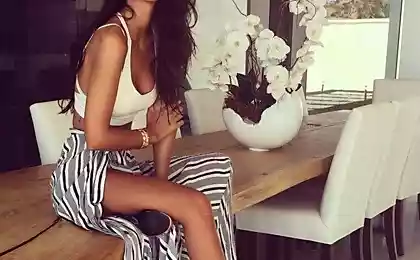1876
What you need to build your own outdoor radiator
Man, going into the room where the floor convector heating installed, and can not guess where there is warm air. The first thing that comes to mind - "Is the carpet on the tracks?". The beauty of floor radiators therein lies: they are invisible to the eyes of people, but regularly acted as room heating
.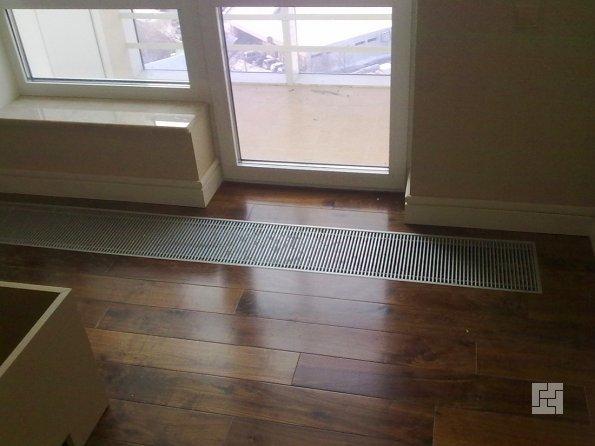
People are increasingly using the physical laws and properties of air to act on it the best way. Another young age technology rapidly becomes massive demand.
This type of heating has been extended in many office and residential premises. Built-in heat sinks have become a real pleasure for designers who year after year to wrestle with how to harmoniously combine the heating elements to the design of the room. Using a conventional battery, to do so would be extremely difficult - hated the pipe and then show up along the windows of prestigious buildings, hiding under the bars. Managers and owners of premises, too, did not remain in the red - embedded heating has proven its superiority
. Convector - heater, whose work is carried out by convection (hot air rises in its place comes colder)
. Floor radiator has become indispensable for the implementation of the system of heating of premises with windows to the floor, swimming pools, halls, showrooms and conservatories. Moreover, many people equip their apartments. And it is not so much the beauty and comfort of accommodation, but also in the design of cost-effectiveness: the system is able to efficiently heat the room. In a family with young children this detkskoy floor in the room will benefit doubly: kids just love to play on the floor, and the heat coming from it will protect the child from the cold
. Floor radiators: design and features
Install floor radiators - excellent heating technology that can effectively and relatively cheaply warm winter gardens, offices, private homes and other premises. Radiators allow to maintain a constant temperature, which under certain conditions is extremely necessary (cultivation of plants, animals, comfortable working conditions). In fact, radiators, recessed into the floor - it convectors use the principle of convection heating. The air is circulated more efficiently than with a conventional heating system.
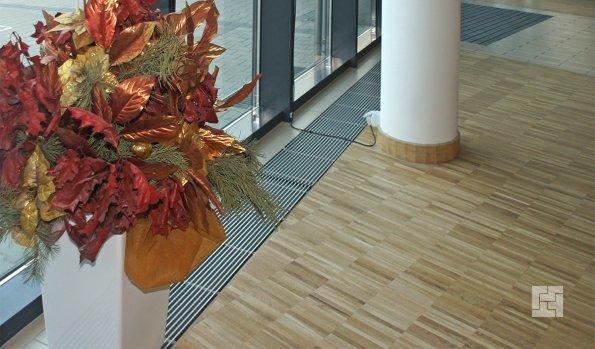
Once the air is in contact with a radiator mounted in the floor, under the influence of warm air convection rises in its place enters cooler. This is carried out air circulation, most of which remains warm, saving big money.
In the XIX century water radiators decorated cast steel flower patterns, and they served as a kind of element of room design. Later, when the radiator began to use everywhere, designers have begun to pay attention to improving the heat transfer.
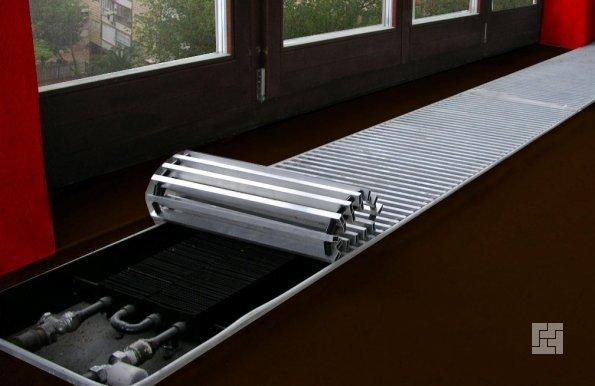
Modern recessed into the floor radiators are an original design. Most often, this heater consists of a heating element of a ribbed structure (such an element appears increasingly less water and gas or electric), decorative panel that hides the entire structure and the channel. This allows you to embed design in tie "to the level of" gender. Lattice convectors seamlessly transmits the cold and hot air, increasing the overall efficiency of performance through the use of the entire surface of the heater.
Advantages and Disadvantages of a floor heating system
Despite the fact that there are heating convectors, water, gas and electric, we analyze the most widespread. These at the moment are water radiators.


Advantages of underfloor heating systems, implemented water convectors:
Comfort. On a warm floor is always a pleasure to walk. Heat transfer takes place from a large area and is visible even at a low temperature heating.
The area is heated uniformly, and it speaks to the uniform heating. In a room with a floor radiator to be comfortable everywhere: near the window, and the middle of the room, and the door
. Efficient distribution of temperature over the entire height of the room.
Cost. Underfloor heating, thanks to the verified technology, will save a significant amount of money.
Hygienic. Air circulation is absent, then drafts are reduced, thus minimizing the amount of circulating dust.
Aesthetics. All the heating elements are not visible, which gives a great advantage in the design of the room. In these areas, you can use any design decisions.
For a more objective assessment always should refer to the "reverse side of the coin».
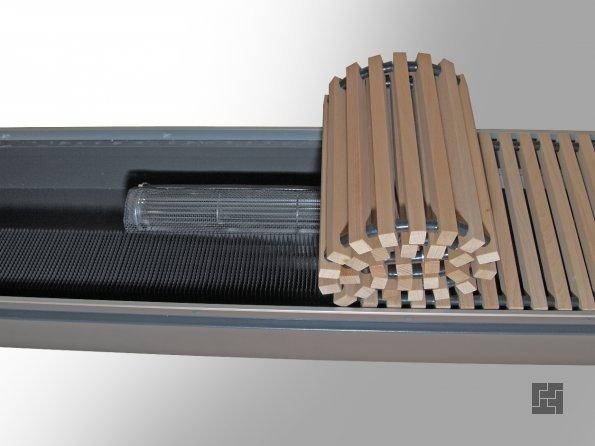
The characteristic disadvantages of such a system include the following:
Underfloor heating can not be implemented in multi-storey buildings with single-pipe heating systems. If such attempts and efforts, the floor temperature reaches 45 degrees. This means that you can step on it only in the shoe.
The need for additional grouting and isolation leads to the need to increase the floor thickness of 13-15 cm. 3. Cost of the underfloor heating when compared with the traditional, much higher.
Installation of radiators: you need to know to radiators in the floor served faithfully for many years
In most cases, underfloor heating installation is relatively simple, it does not require special knowledge and skills. The main thing is to have a general idea of the heat engineering and some experience in construction work. However, there are a number of pitfalls that may be encountered during installation. Knowing them and having an idea how to get around them, you can save money and nerves.
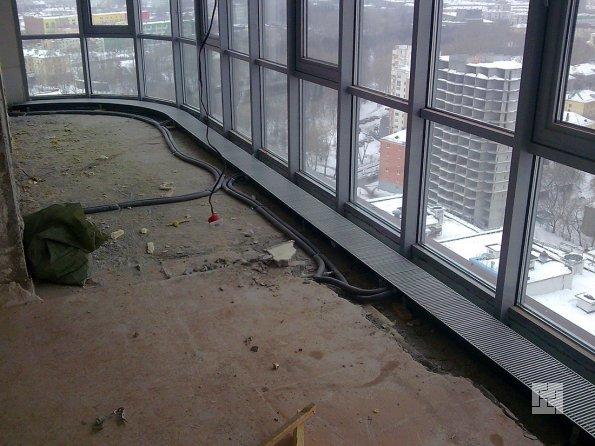
Pressure. Trench radiators with convection mode of operation ideal for private homes and cottages, where the pressure is relatively small (2, 5 atm). If you install such a system in multi-storey buildings where the pressure varies from 6 to 12 bar, it is necessary to use copper panels, which are able to carry such loads.
Remember, the first thing you need to pay attention to - the pressure device and the heating system must match. Do not forget to check readings convector instructions.
Ceiling height. From this parameter depends on the thermal capacity of the purchased equipment. The higher the ceiling, the more powerful equipment must be purchased in order to effectively heat the entire volume of air. In most cases, you can calculate the power required by the formula 1 kW on a 10m2 area.
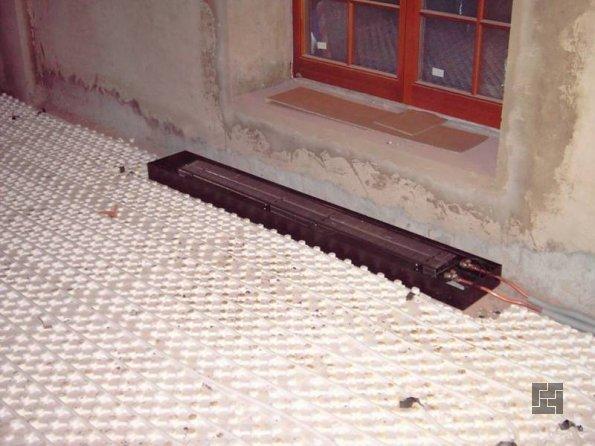
The choice of equipment. As a rule, the majority of radiators are identical in features and design. But some models are equipped with additional fans to circulate the air, which improves overall performance.
By following these simple guidelines, you can easily implement a floor heating system that will work effectively for many years.
Choosing the best radiator. Video
A well-designed system of heating the house with his own hands, using outdoor heaters in the first place depends on the equipment. Do not make a mistake and select a heat sink, which is a necessary characteristic - priority matter
.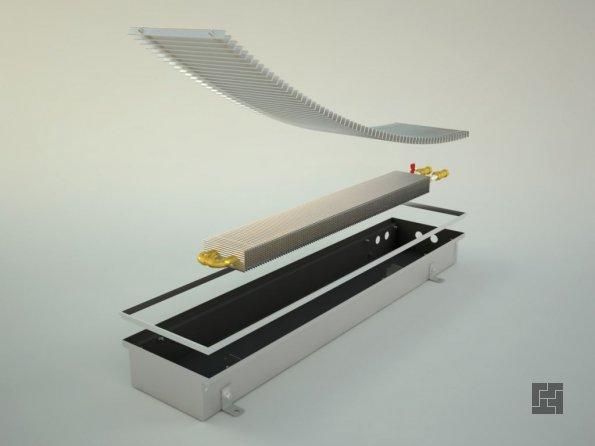
Today, inside-batteries - is still quite young and innovative technology. But despite this, they are very popular, are increasingly replacing traditional heating methods.
Market goes to meet the consumer and is ready to offer a greater number of options, ranging from the cost of radiators designed for heating small areas, up to the production of solutions satisfying the largest objects. A variety of materials, shapes and sizes allows you to choose the best solution for everyone.
.

People are increasingly using the physical laws and properties of air to act on it the best way. Another young age technology rapidly becomes massive demand.
This type of heating has been extended in many office and residential premises. Built-in heat sinks have become a real pleasure for designers who year after year to wrestle with how to harmoniously combine the heating elements to the design of the room. Using a conventional battery, to do so would be extremely difficult - hated the pipe and then show up along the windows of prestigious buildings, hiding under the bars. Managers and owners of premises, too, did not remain in the red - embedded heating has proven its superiority
. Convector - heater, whose work is carried out by convection (hot air rises in its place comes colder)
. Floor radiator has become indispensable for the implementation of the system of heating of premises with windows to the floor, swimming pools, halls, showrooms and conservatories. Moreover, many people equip their apartments. And it is not so much the beauty and comfort of accommodation, but also in the design of cost-effectiveness: the system is able to efficiently heat the room. In a family with young children this detkskoy floor in the room will benefit doubly: kids just love to play on the floor, and the heat coming from it will protect the child from the cold
. Floor radiators: design and features
Install floor radiators - excellent heating technology that can effectively and relatively cheaply warm winter gardens, offices, private homes and other premises. Radiators allow to maintain a constant temperature, which under certain conditions is extremely necessary (cultivation of plants, animals, comfortable working conditions). In fact, radiators, recessed into the floor - it convectors use the principle of convection heating. The air is circulated more efficiently than with a conventional heating system.

Once the air is in contact with a radiator mounted in the floor, under the influence of warm air convection rises in its place enters cooler. This is carried out air circulation, most of which remains warm, saving big money.
In the XIX century water radiators decorated cast steel flower patterns, and they served as a kind of element of room design. Later, when the radiator began to use everywhere, designers have begun to pay attention to improving the heat transfer.

Modern recessed into the floor radiators are an original design. Most often, this heater consists of a heating element of a ribbed structure (such an element appears increasingly less water and gas or electric), decorative panel that hides the entire structure and the channel. This allows you to embed design in tie "to the level of" gender. Lattice convectors seamlessly transmits the cold and hot air, increasing the overall efficiency of performance through the use of the entire surface of the heater.
Advantages and Disadvantages of a floor heating system
Despite the fact that there are heating convectors, water, gas and electric, we analyze the most widespread. These at the moment are water radiators.


Advantages of underfloor heating systems, implemented water convectors:
Comfort. On a warm floor is always a pleasure to walk. Heat transfer takes place from a large area and is visible even at a low temperature heating.
The area is heated uniformly, and it speaks to the uniform heating. In a room with a floor radiator to be comfortable everywhere: near the window, and the middle of the room, and the door
. Efficient distribution of temperature over the entire height of the room.
Cost. Underfloor heating, thanks to the verified technology, will save a significant amount of money.
Hygienic. Air circulation is absent, then drafts are reduced, thus minimizing the amount of circulating dust.
Aesthetics. All the heating elements are not visible, which gives a great advantage in the design of the room. In these areas, you can use any design decisions.
For a more objective assessment always should refer to the "reverse side of the coin».

The characteristic disadvantages of such a system include the following:
Underfloor heating can not be implemented in multi-storey buildings with single-pipe heating systems. If such attempts and efforts, the floor temperature reaches 45 degrees. This means that you can step on it only in the shoe.
The need for additional grouting and isolation leads to the need to increase the floor thickness of 13-15 cm. 3. Cost of the underfloor heating when compared with the traditional, much higher.
Installation of radiators: you need to know to radiators in the floor served faithfully for many years
In most cases, underfloor heating installation is relatively simple, it does not require special knowledge and skills. The main thing is to have a general idea of the heat engineering and some experience in construction work. However, there are a number of pitfalls that may be encountered during installation. Knowing them and having an idea how to get around them, you can save money and nerves.

Pressure. Trench radiators with convection mode of operation ideal for private homes and cottages, where the pressure is relatively small (2, 5 atm). If you install such a system in multi-storey buildings where the pressure varies from 6 to 12 bar, it is necessary to use copper panels, which are able to carry such loads.
Remember, the first thing you need to pay attention to - the pressure device and the heating system must match. Do not forget to check readings convector instructions.
Ceiling height. From this parameter depends on the thermal capacity of the purchased equipment. The higher the ceiling, the more powerful equipment must be purchased in order to effectively heat the entire volume of air. In most cases, you can calculate the power required by the formula 1 kW on a 10m2 area.

The choice of equipment. As a rule, the majority of radiators are identical in features and design. But some models are equipped with additional fans to circulate the air, which improves overall performance.
By following these simple guidelines, you can easily implement a floor heating system that will work effectively for many years.
Choosing the best radiator. Video
A well-designed system of heating the house with his own hands, using outdoor heaters in the first place depends on the equipment. Do not make a mistake and select a heat sink, which is a necessary characteristic - priority matter
.

Today, inside-batteries - is still quite young and innovative technology. But despite this, they are very popular, are increasingly replacing traditional heating methods.
Market goes to meet the consumer and is ready to offer a greater number of options, ranging from the cost of radiators designed for heating small areas, up to the production of solutions satisfying the largest objects. A variety of materials, shapes and sizes allows you to choose the best solution for everyone.























